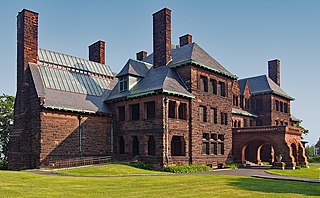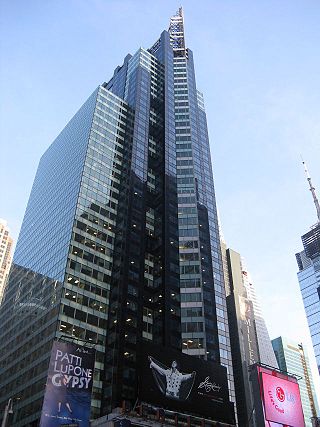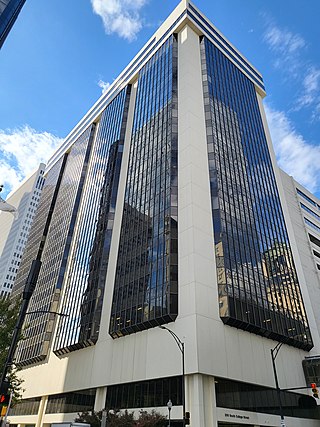
James Jerome Hill was a Canadian-American railroad director. He was the chief executive officer of a family of lines headed by the Great Northern Railway, which served a substantial area of the Upper Midwest, the northern Great Plains, and Pacific Northwest. Because of the size of this region and the economic dominance exerted by the Hill lines, Hill became known during his lifetime as "The Empire Builder", and died in 1916 with a fortune of about 63 million dollars. His former home, James J. Hill House, is now a museum in Saint Paul, Minnesota.

The Burlington Northern Railroad was a United States-based railroad company formed from a merger of four major U.S. railroads. Burlington Northern operated between 1970 and 1996.

Capella Tower is an office skyscraper in Minneapolis, Minnesota, United States. The building opened in 1992 as First Bank Place, replacing One Financial Plaza as the headquarters for First Bank System. In 1997, First Bank System acquired US Bancorp and changed the name of the building to US Bancorp Place. The headquarters of US Bancorp moved into the US Bancorp Center in 2000, whereupon the tower changed to 225 South 6th Street. In March 2009, the building took its present name.

Saint Paul Union Depot is a historic railroad station and intermodal transit hub in the Lowertown neighborhood of the city of Saint Paul, Minnesota, United States. It serves light rail, intercity rail, intercity bus, and local bus services.

Cray Plaza, located in the Lowertown neighborhood of Saint Paul, Minnesota, United States, provides space for working, living, eating, and recreating on one square city block opened in 1986.

The Soo Line Building is a 19-story residential highrise in Minneapolis, Minnesota which was the tallest commercial building in the city from the time it was completed in 1915 until the 26-story Foshay Tower was built in 1929.

The James J. Hill House in Saint Paul, Minnesota, United States, was built by railroad magnate James J. Hill. The house, completed in 1891, is near the eastern end of Summit Avenue near the Cathedral of Saint Paul. The house, for its time, was very large and was the "showcase of St. Paul" until James J. Hill's death in 1916. It is listed as a U.S. National Historic Landmark, operated by the Minnesota Historical Society. It is also a contributing property to the Historic Hill District.

Gaviidae Common is a mixed-use shopping mall and office complex on Nicollet Mall in Minneapolis, Minnesota. The first phase of the mall, Gaviidae Common I, opened in 1989 and is adjoined to Gaviidae Common II by a series of skyways. Phase II opened in 1991. A joint venture designed by Argentine American architect César Pelli and Chicago-based Lohan Associates, the mall occupies 443,000-square-foot (41,000 m2) of retail and office space spread across five floors. Following the closure of the mall's food court and several tenants in 2013, the top three floors of Gaviidae Common II were converted into office and recreational space for the adjoining RBC Plaza.
Shingle Creek Crossing, formerly Brookdale Center, is a regional shopping mall in Brooklyn Center, Minnesota. It became the third enclosed shopping mall in the Twin Cities, after Southdale Center and Apache Plaza. The mall opened in phases beginning with Phase One in March 1962 which included anchor stores Sears and JCPenney. Phase Two opened in 1966, adding Dayton's as the third anchor. Donaldson's became the fourth anchor in September 1967. Brookdale Center was part of "The Dales", what was referred to as the four "Dale" centers circling the Twin Cities, originally developed by Dayton-Hudson Corporation. The others are Southdale Center in Edina, Rosedale Center in Roseville and Ridgedale Center in Minnetonka. After a long decline, the mall closed in 2010 and was demolished in 2012 before being redeveloped into the Shingle Creek Crossing development.

The Minneapolis Great Northern Depot, also known as Great Northern Station, was a passenger railroad station which served Minneapolis, Minnesota, USA. It was built in 1913 and demolished in 1978. It was located on Hennepin Avenue next to the Hennepin Avenue Bridge and across the street from the main Minneapolis Post Office.

1540 Broadway, formerly the Bertelsmann Building, is a 44-story office building on Times Square in the Theater District neighborhood of Manhattan in New York City. Designed by David Childs of Skidmore, Owings & Merrill (SOM), the building was developed by Broadway State Partners, a joint venture between Bruce Eichner and VMS Development. 1540 Broadway occupies a site bounded by Broadway to the west, 45th Street to the south, and 46th Street to the north. It was originally named for its anchor tenant, German media company Bertelsmann. The building is divided into two ownership units: HSBC and Edge Funds Advisors own the office stories, while Vornado Realty Trust owns retail space at the base.

33 South Sixth, formerly known as International Multifoods Tower, is a skyscraper in Minneapolis, Minnesota. It was designed by Skidmore, Owings and Merrill and stands 52 stories tall at 668 ft (204 m). Its name comes from its address: 33 South Sixth Street, Minneapolis. It was completed in 1983 as headquarters for International Multifoods Corporation, which occupied the structure until 1997 when it moved to suburban Wayzata. Although the corporate offices relocated, the name remained until 2003 under the terms of its lease. Adjacent to the tower is the Minneapolis City Center shopping mall, which occupies the ground level, skyway, and third levels.

200 South College is a 300-foot (91 m) high-rise in Charlotte, North Carolina. Completed in 1975, it consists of 22 floors, a 11-story parking garage, and on the second floor it is connected to neighboring buildings via skybridges, as part of the Overstreet Mall.

The Lowertown Historic District is a historic district in the Lowertown neighborhood of Saint Paul, Minnesota, United States. This 16-block warehouse and wholesaling district comprises 37 contributing properties built 1870s–1920. It was listed on the National Register of Historic Places in 1983 for the significance of its river and rail connections, economic impact, architecture, and urban planning. Lowertown was originally the lower landing on the Mississippi River; the first port of access to the Twin Cities. Several warehouse, railroad, banking, and distribution buildings served the entire Upper Midwest from 1880 to 1920. A significant concentration of these buildings survive, unified by similar architectural styles and construction materials. Many were designed by the city's most prestigious architects, including Cass Gilbert and Clarence H. Johnston Sr.

Downtown Saint Paul is the central business district of Saint Paul, Minnesota, United States. Its boundaries are the Mississippi River to the south, University Avenue to the north, US 52 to the east, and Kellogg Avenue to the west. It is bounded by the Dayton's Bluff, Summit-University, West Seventh, Frogtown, West Side, and Payne-Phalen neighborhoods. The West Side neighborhood is on the other side of the river, and can be accessed via the Robert Street Bridge or the Wabasha Street Bridge. Interstate 35E and Interstate 94 run through the north side of the neighborhood, providing a separation between the Minnesota State Capitol and other state government buildings with the rest of downtown.

The St. Louis County Depot is a historic railroad station in Duluth, Minnesota, United States. It was built as a union station in 1892, serving seven railroads at its peak. Rail service ceased in 1969 and the building was threatened with demolition until it reopened in 1973 as St. Louis County Heritage & Arts Center . Train service also resumed from 1974 to 1985, by Amtrak.

Bronx Terminal Market, formerly known as Gateway Center at Bronx Terminal Market, is a shopping mall along the Major Deegan Expressway in Concourse, Bronx, New York. The center encompasses just under one million square feet of retail space built on a 17-acre (69,000 m2) site that formerly held a wholesale fruit and vegetable market as well as the former Bronx House of Detention, south of Yankee Stadium.

Telus Sky, is a 59-storey, 222.3 m (729 ft) mixed-use skyscraper in downtown Calgary, Alberta, Canada. At completion in 2019, the structure building became the third-tallest building in Calgary behind Brookfield Place East and The Bow. As of July 2020, Telus Sky is the 18th tallest building in Canada, though several buildings in Toronto exceeding its height are under construction including The One.

WaHu Student Apartments is a luxury residential apartment building located in Minneapolis, Minnesota. It was first announced in 2012 with intent to cater to the campus population of the nearby University of Minnesota. The complex comprises 327 residential units within three apartment towers. It also contains designated retail space, currently leased by tenants such as Bank of America, Blaze Pizza, and local restaurants.

Minneapolis City Center is a mixed-use shopping mall on Nicollet Mall in Minneapolis, Minnesota. It opened in 1983 and occupies the bottom three floors of the 33 South Sixth office building. Designed by Skidmore, Owings & Merrill, Minneapolis City Center contains 250,000 square feet (23,000 m2) of leasable retail space. The mall was built around the pre-existing Forum Cafeteria restaurant. The building is adjacent to the Marriott Hotel City Center and connected to the Gaviidae Common shopping mall.



























